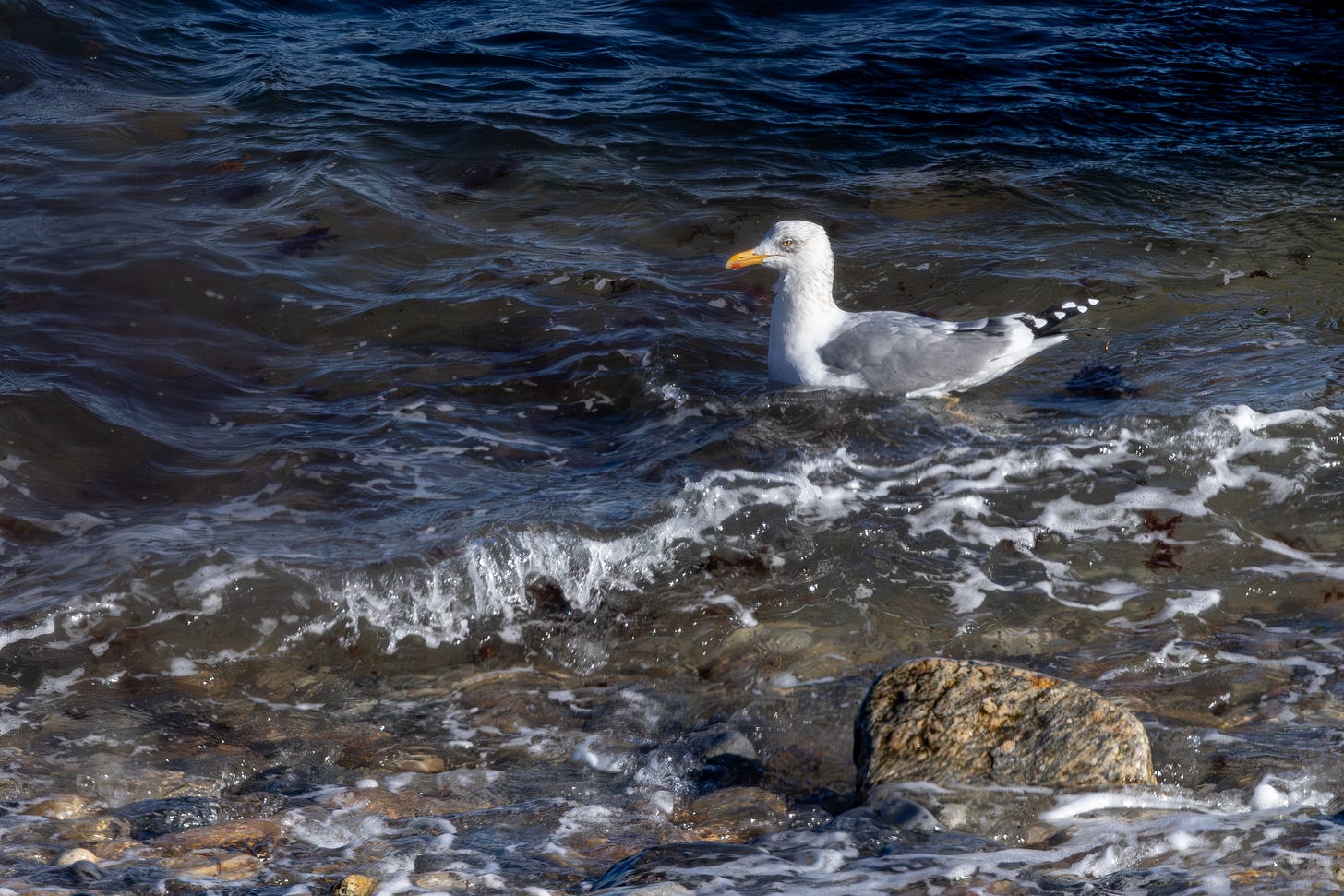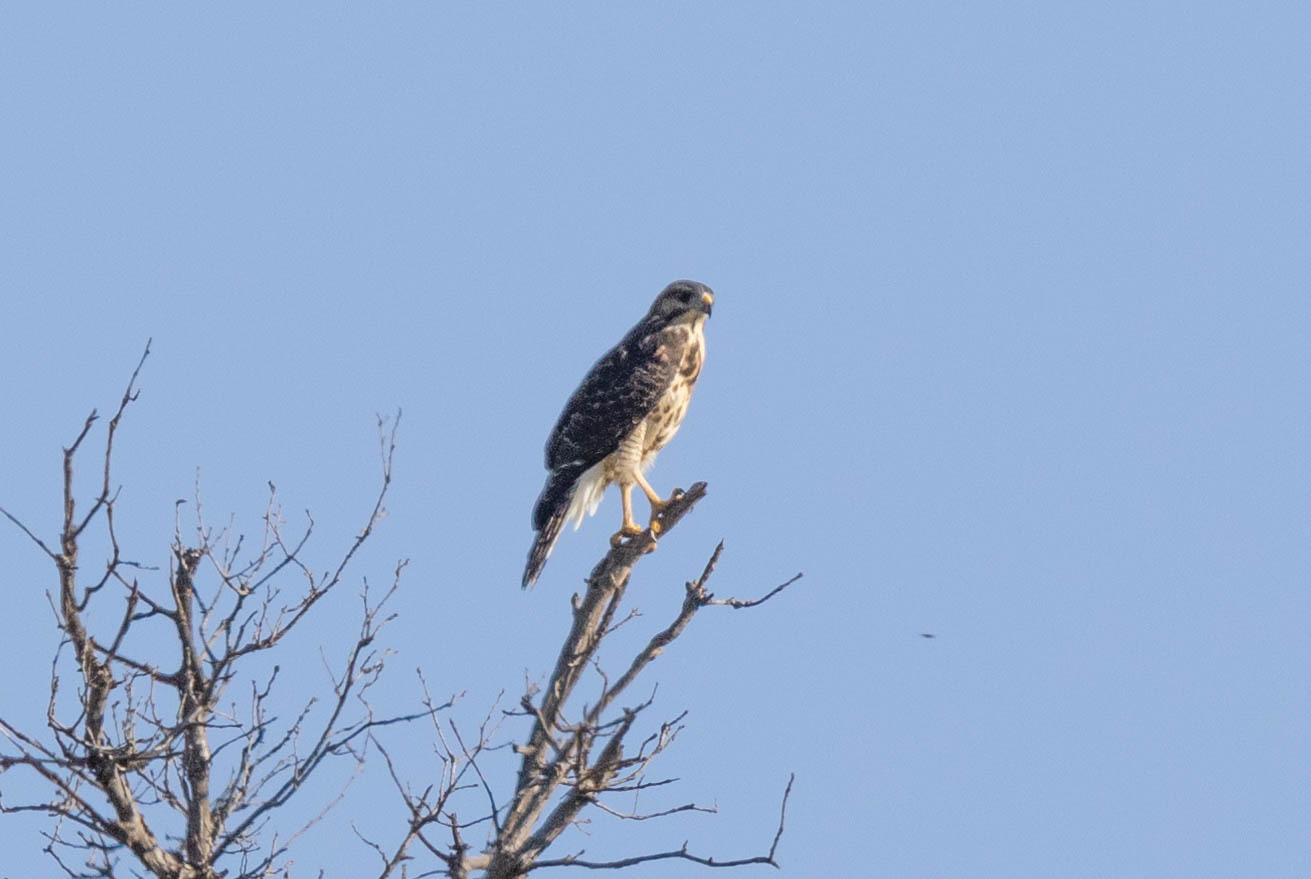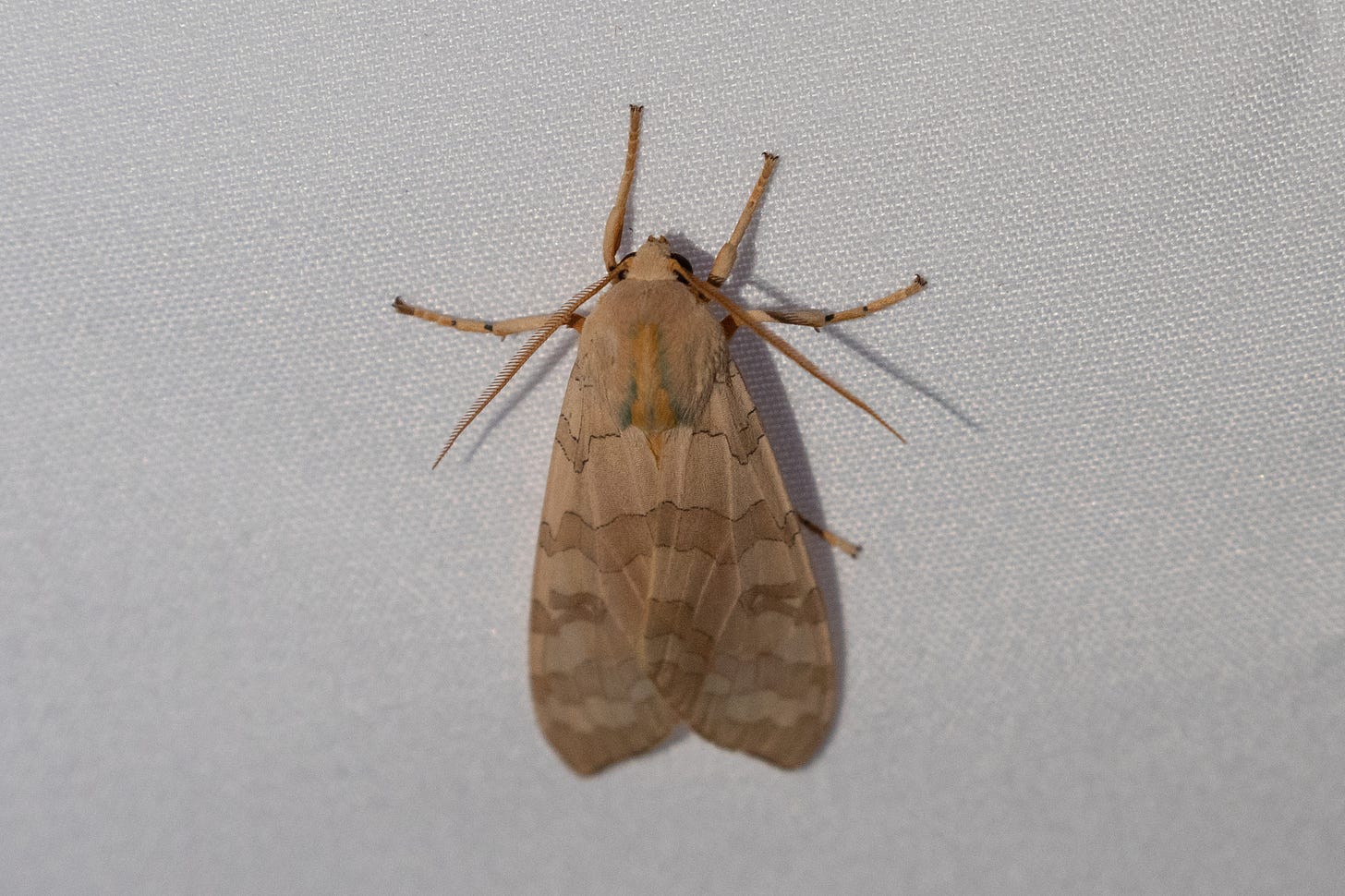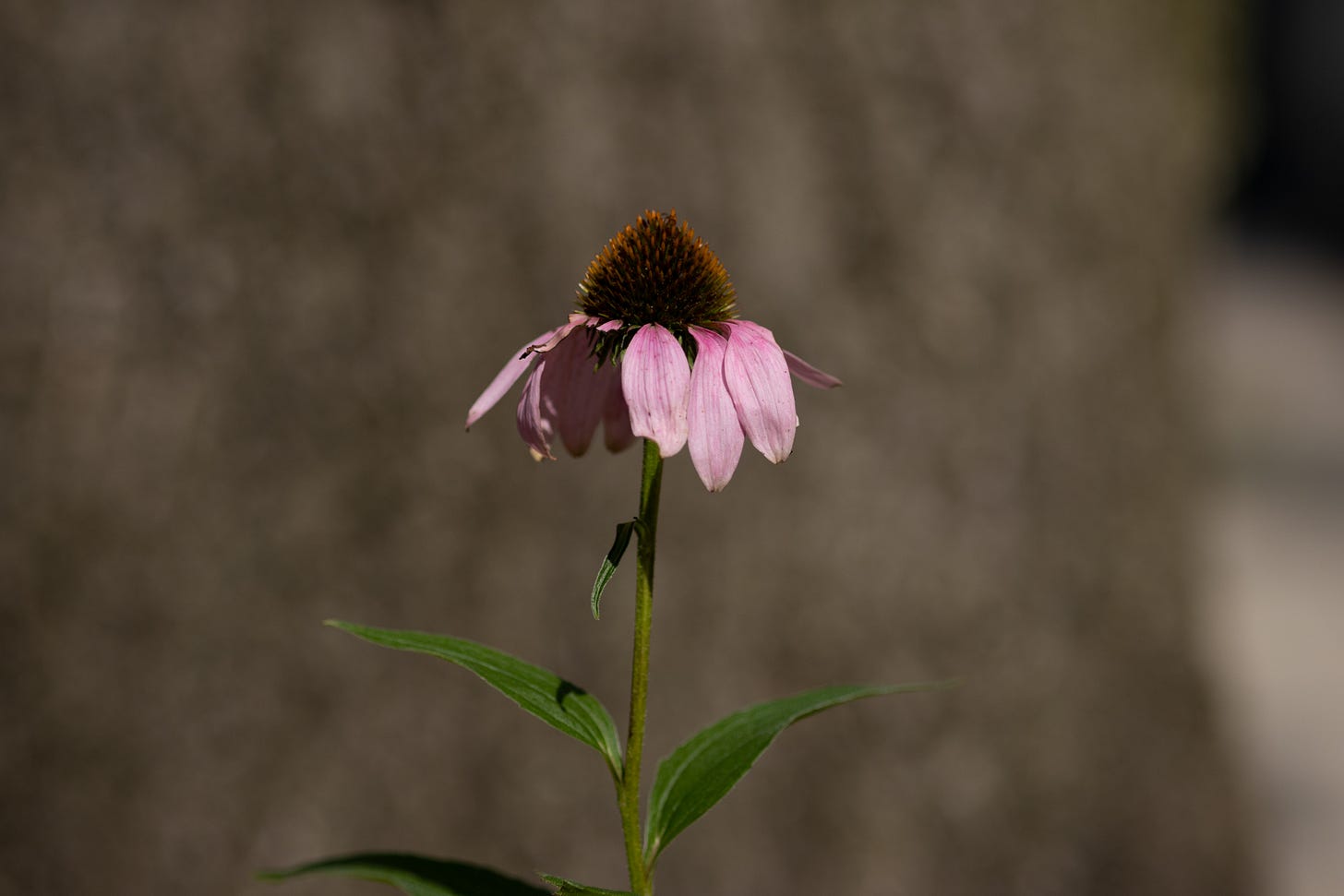back in 2021, i photographed a handsome moth in brooklyn’s prospect park. it was an understated creature that rewarded a close look: tan with black-outlined brown stripes across its wings, its back a daub of orange slightly covered by blue-fringed tan curtains. what was it? well, i’d been observing moths for a few months and i was starting to get the hang of it. i opened my field guide, turned to the page with the paper airplane-shaped tiger moths, and found one identical in every way to my creature: the banded tussock moth. easy.
i posted the image and species name online without a second thought, confident in my moth identification skills. but shortly after, i received a comment from my friend (and far more experienced naturalist) taylor. “I don’t think it can be separated from sycamore [tussock moth] without observing the male genitalia.” the sycamore tussock moth wasn’t even in my field guide. but of course, taylor was right—the sycamore tussock moth adult looks identical to the banded tussock moth, and is common in nyc. though i’d successfully identified hundreds of moth species by then, everything came crashing down. i don’t know shit.
these blows happen regularly enough that today, i know more than ever…and i feel like i don’t know more than ever. it’s a common pattern across any area of expertise, feeling most confident after picking up the basics and taking a long time, perhaps years, before acquiring enough skill to know when to say “i don’t know.” i’ve been reflecting on what this means on the eve of my book’s publication and of course in the broader context of our idiot-run country. how can one disseminate and receive information accurately when confidence isn’t correlated with experience?

i’ll start by explaining “experience.” for my nature-watching hobby, it means internalizing that the world is far bigger than it appears, its rules unsatisfyingly fluid, and its observers inherently biased. for example, in just a year or two, one could learn to confidently identify all of new york city’s expected birds by sight and sound. but it takes longer to learn that birds feature an incredible diversity of life histories, behaviors, appearances, and contexts—even within a single species. i learn a lot from observing one individual for a while, but one can’t necessarily extrapolate those lessons to the next individual. knowledge requires many observations, and expectations set by an individual could be broken by the next one.
my friend tim tells a great story about a small black-backed seagull he photographed. tim has seen a lot of nyc’s two black-backed gull species, and this one appeared far too small to be the “great” one, but looked totally unlike the “lesser” one. he sent his photos to an expert. the expert responded “wow!” without further comment, sending tim into an anxious spiral—was it some mega rare seagull from the southern hemisphere?—until the expert finally responded that the bird was a shockingly runty version of the abundant great black-backed gull.
meanwhile, it would be hard to overstate a cameras’ ability to distort size, shape, and color to the point that a photograph can present the illusion of a different species versus its real-life identity. photographers are biased to assume the picture shows the creature it appears to show (or what they want it to show) rather than what sat in front of them. every year i see a photo of a distant loon where the sun hits the beak just right, making it appear like the rare yellow-billed loon and sending birders into disarray. in most cases, it’s a common loon.
and the nuance. oh, the nuance! moving on from birds: a few years ago i got excited about a purple coneflower that started growing in my apartment’s tree planter on its own, since i knew coneflower was a native species. nope, stupid ryan. sure, it’s native to parts of the eastern united states and part of native plant seed mixes because it’s good at growing. but technically it is not native to new york city. trying to understand the coneflower in the planter will one day be an eyy i’m walkin here post itself.
given that context, experienced nature observers deploy the phrase i don’t know often, even in places where they might have previously been confident. my friend asked me to identify birds in a recording recently—it was the call of a red-shouldered hawk, followed by the calls of blue jays. i could have told him as much. but instead i told him i don’t know for sure, because experience has told me that blue jays often mimic red-shoulders.
it might seem frustrating at first, but i don’t know is an exciting, powerful phrase. it sends you off in new directions, opens your mind to new possibilities, and prepares you for the next situation. if i don’t know, then there’s something left to learn, something to write for the newsletter. and the core reason i go look at animals all day is because i really like learning and sharing.
but the frustrating-at-first part is also the source of peril. “i don’t know” and nuance doesn’t instantly satisfy our internet-addled minds, or in the case of nature observation, our impulse to check boxes and build lists of species like we’re collecting pokemon for our pokedex. not to mention that experts who feel like they don’t know are probably less likely to provide an answer unless asked. and most insidiously, we often don’t know what we don’t know—the result is, as i mentioned before, confidence and knowledge are often uncorrelated.

fans of popular science writing know that this anticorrelation has a name: the dunning-krueger effect. back in 1999, psychologists david dunning and justin krueger published a paper detailing four studies comparing participants’ test scores with self-assessments on how well they thought they did. dunning and krueger found that on average, those scoring in the lowest percentile far overestimated their ability. from a summary of that paper: “people tend to hold overly favorable views of their abilities in many social and intellectual domains… this overestimation occurs, in part, because people who are unskilled in these domains suffer a dual burden: not only do these people reach erroneous conclusions and make unfortunate choices, but their incompetence robs them of the metacognitive ability to realize it.”
the result is the easily availability of confident answers made by those unaware of their inexperience. and perhaps equally worrying is the creations of human-less tools that will dispense such experience-free answers without accountability. in birding, this means reliance on apps that use image recognition in order to identify species. though quick and easy, these apps are unlikely to say “i don’t know” and incapable of dispensing nuance based on experience. i am not opposed to them—accessibility of knowledge is an incredible thing—but i wish they were more forthcoming about their limitation, and that users were encouraged to seek out the broader context that comes with interactions with other people. i quite like how the inaturalist app attempts to provide both ai-generated help and interactions with experienced humans.
why does all of this matter—it’s just a hobby, isn’t it? well, overconfident non-expertise and blind reliance on the outputs of artificial intelligence are pervasive far beyond birding. self-declared expertise fueled solely by confidence has led to the opinions of folks without a broader grasp of the topic having an outsized impact on the public’s understanding or on decisions. then we end up with robert f. kennedy jr. as the secretary of health and human services (and i don’t think i need to get into what blind reliance on ai has done to the internet). bringing it back to birds, i also contend that this effect is partially responsible for the death of flaco the owl, with discourse led by random people online rather than experts on urban ecology or captive animals.

i love nature and i love sharing what i know. by no means do i want to stop others from doing the same. trust me, i was sharing my knowledge and identifying birds for random people on the internet months after i first picked up binoculars. and i will never stop writing excitedly about things i have only just learned about—that’s a big part of being a journalist. but journalism school also gave me some ideas about how to be aware of my own limitations. my book starts with a page-long reflection on my experience, and explicitly tells the reader that it’s a book by a near-novice for novices, that we’re discovering the city together. i try to reflect on my limits and then speak solely from my own knowledge and experience, adding caveats detailing those limits. i seek out mentorship and expertise from those who know more, and build my knowledge from multiple kinds of sources. i try to be aware of what i do and don’t know, and try to be wrong transparently. i hope all of us overconfident newbies can work together to build some self-awareness on this front.
it’s certainly not the sole responsibility of newbies to self-regulate, though, since it’s hard for one to tell whether they’re overconfident or a seasoned expert—we don’t know what we don’t know. more important, in my opinion, is experienced folks offering patient, empathetic mentorship with kindness. we should work to build a culture of being excited not just about what we know but also what we don’t know, and when necessary, accept being wrong as an opportunity to be right next time. and i think we can all do better providing thoughtful mentorship—we were all new once.
but ultimately…………………….i don’t know what the hell i’m talking about.
—
postscript: while written by a self-proclaimed near-novice, my book is fact-checked (THANK YOU ELIZA) and was reviewed by people way smarter than me :) so you should buy it :) because it’s good :)
that being said, since it’s book release season (april 22!!!!!!), i have lots of cool things coming up that you should save the date for!
events:
bird trivia, march 20, 7pm @ the ditty in astoria. free, registration is encouraged. come ready to win!!
bird walk, april 19, 8am @ owl’s head park in bay ridge. free, registration is encouraged.
bird walk, talk, and drag show, april 23, time tba @ sunset stoop in sunset park. details tba but it’s going to be awesome.
pigeon portraits and prose, may 3, 1:30-3:00pm @ caveat. $15, tickets available here. chelsea and i are hosting an irreverent nature writing and illustration workshop called. i am SO EXCITED.
intro to birding, may 4, 9-10:30am @ marine park salt marsh nature center. free, no registration required.
golden hour bird walk, may 8, 6-7:30pm @ prospect park stranahan monument. free, registration encouraged.
bird walk, may 18, 9:30-11am @ wave hill. free with admission to the grounds.
—
ok last thing! i like to spend my birthday someplace else, and this year britt and i went to sax-zim bog in northern minnesota to try my hand at seeing some owls. i saw a lot—one boreal owl, one snowy owl, two northern hawk-owls, and seven great gray owls! i am writing about it for the brooklyn bird club newsletter and will share that story here once it’s out. but my favorite animal i saw was the bog’s famous pine marten, who occasionally stops by one of the bird feeders to feast on peanut butter.





